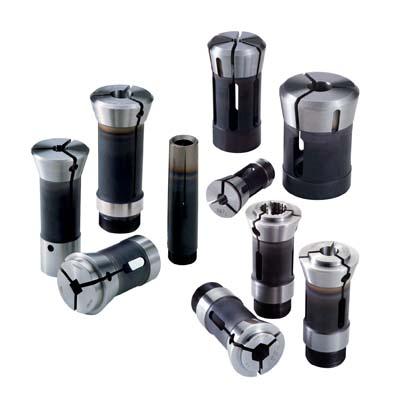
Hardinge Inc. supports European-style, multi-spindle machine owners in North America. They manufacture and inventory solid collets, master collets and pads, solid feed fingers and master feed fingers and pads for Euroturn, Gildemeister, Index and Schutte machines with 24-hour shipping of standard fractional and whole metric sizes. Decimal sizes and products for other brands of machines will be available within a 5- to 7-day delivery. Hardinge institutes a semi-finished blank program for fast turnaround of pickoff burring collets and special-shape collets.
According to Hardinge, the collet should match the bar stock exactly. If you use inch bar stock, you should use fractional collets, not metric. Very few metric sizes have a direct fractional equivalent. Metric collets for metric bar stock, fractional collets for inch bar stock, and decimal collets for decimal bar stock will provide the best results. Match the collet size (order hole) exactly to the workpiece or bar stock diameter. If you are using ¼-inch bar stock with a 6mm collet, you could get push-back, chatter or poor concentricity because the collet is smaller than the bar stock.
"Most operators don't realize the ramifications of such a small variance in diameter," says Rick Schonher, Hardinge Workholding product manager. "If the collet order hole is larger than the workpiece or bar stock, the part may pivot at the line of contact at the face of the collet. If the collet order hole is smaller than the workpiece or bar stock, the edges of the slots will bite into the workpiece and may cause damage or mark the bar. When the collet is the proper size for the workpiece or bar stock, there is a full bearing along the angle and the circumference of each segment of the collet where they mate with the spindle angle (seat)."
Contact Details
Related Glossary Terms
- chatter
chatter
Condition of vibration involving the machine, workpiece and cutting tool. Once this condition arises, it is often self-sustaining until the problem is corrected. Chatter can be identified when lines or grooves appear at regular intervals in the workpiece. These lines or grooves are caused by the teeth of the cutter as they vibrate in and out of the workpiece and their spacing depends on the frequency of vibration.
- collet
collet
Flexible-sided device that secures a tool or workpiece. Similar in function to a chuck, but can accommodate only a narrow size range. Typically provides greater gripping force and precision than a chuck. See chuck.
- feed
feed
Rate of change of position of the tool as a whole, relative to the workpiece while cutting.
